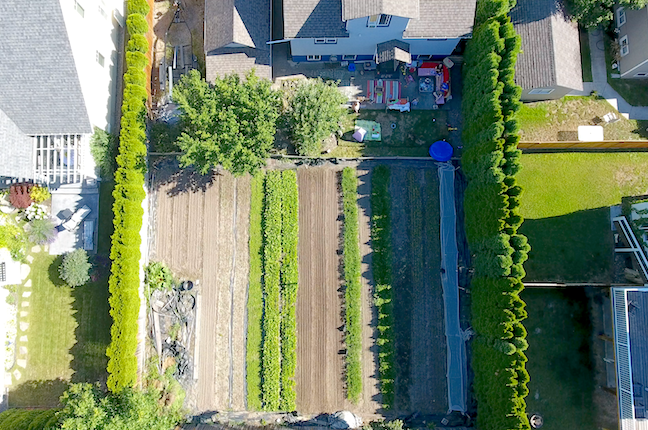This Guy Started an Urban Farm and Now He Makes $75,000 a Year

It all started with an ice storm.
Curtis Stone was living in Montreal, Canada, when the city was hit by a storm that left everything covered in two inches of ice.
“The city was in pandemonium for days, the grocery stores were almost empty, and I realized how fragile the food system was,” Stone says. This experience led him to learn about growing his own food and, ultimately, start his own small organic farm.
In 2010, he established Green City Acres in Kelowna, British Columbia, a small city in Canada’s fruit-growing and winemaking region. By 2012, he was producing 50,000 pounds of food a year — and making $75,000.
Becoming an Urban Farmer

At first, Stone turned to YouTube to learn how to live off the land and grow things organically.
“I didn’t know anything about farming when I started,” he says. “I read books, watched tons of videos, made tons of mistakes and kept going on.”
In 2008, he moved to Kelowna from Montreal. Soon after, he biked from Kelowna to Tijuana, Mexico, visiting homesteads, ecovillages and organic farms along the way.
“I was inspired by what was possible,” he says. When he returned to Kelowna, he began developing his farm.
Maximizing a Small Urban Farm

Green City Acres actually isn’t just one farm — it includes six locations, all within a square kilometer (about one-third of a square mile).
“It’s a decentralized farm,” Stone says, explaining how he uses mainly the front and backyards of homes, including his own. He’s added a passive solar greenhouse, cold storage and harvesting areas to boost efficiency.
The greenhouse allows Stone and his team to grow microgreens and herbs year-round.
Because of the small amount of land — the whole farm totals less than 0.4 of an acre — Stone uses “bio-intensive” farming methods.
“‘Bio-intensive’ means giving the crop only the space needed to get to full maturity,” he says. “The beds are densely planted, and we’re growing everything in a 30-inch wide bed.”
The densely packed plants act as mulch and help retain water, prevent erosion and suppress weeds.
An added bonus?
“It has ergonomics built in,” Stone says. “A person can comfortably straddle it and work… You can walk in and out of plots, crossing over beds easily. We’re focusing on crops that require a lot of planting, replanting and harvesting, and we need to be able to get in and out of plots.”
How He Makes $75,000 a Year from Only 15,000 Square Feet

Green City Acres grows about 20 different plants, which have a few general characteristics in common.
Stone focuses on crops that are ready within 60 days and have high yields (generally 2-2.5 pounds per square foot).
He also makes sure to grow plants that demand a high price per pound.
“We’re not growing things like potatoes and winter squash,” he explains. “We’re growing cut salad greens, fine fresh herbs, microgreens, cherry tomatoes.”
Stone also aims to grow crops that have long seasons.
“If we’re growing a tomato variety, we want a tomato that we can have from the beginning of June to the end of October,” he says.
The final key characteristic is popularity.
“We’re only growing crops that people demand,” he says. “I’ve experimented with growing 80 different types of vegetables and found at the end of the day, if you don’t grow what people want, you’re not going to make money farming.”
Stone sells his produce to niche grocery stores, farmers markets, restaurants and CSA programs.
How to Start Urban Farming

If you want to grow a profitable urban garden, Stone advises you to start small.
“Start with a small piece of land,” he explains. “It doesn’t have to be much. The most ideal way is to start with one or two backyards.”
He encourages people to use the 30-inch bed and some of his other methods and scale these techniques to demand.
“Start with half a bed of arugula, start with a small diversity of crops, but don’t get too crazy,” Stone says.
He recommends starting with around five crops, adding that the best ones for beginners to grow are salad crops, like red Russian kale, lettuce, mustard greens, spinach and arugula.
“With five crops, you can have maybe 10 different products, which gives you optionality,” Stone explains.
“If you’re short on this one this week, just add it to the salad mix. That’s a really easy way to get started and get things growing.”
Following the Market

Ultimately, Stone lets the market tell him what to grow.
“Let the market pull you instead of having an idea and going out to sell,” he says. “Let it tell you what to grow and what people want. If you understand the techniques and are able to learn on the fly and change your production based on what the market is telling you, you can be profitable very quickly.”
Stone encourages new farmers to start at farmers markets, but only if they’re not packed with others selling the same types of crops.
Green grocers (like Whole Foods or Trader Joe’s), small restaurants, owner-operator cafés and collaborative CSA programs are a few alternate markets he suggests.
“The key is to never start in a saturated market,” Stone says. “Go where you can carve out a little niche.”
In addition to his farming work, Stone has also created a niche for himself in guiding others to become farmers. He published an Amazon-bestselling book about his techniques, and also offers a 10-week self study course for “farmpreneurs,” which about 200 people have taken.
Your Turn: Have you ever tried urban farming? Can you share any tips for other would-be growers?
Kristen Pope is a freelance writer and editor in Jackson Hole, Wyoming.


















